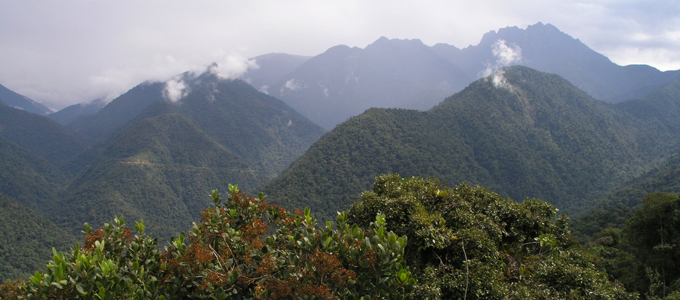The eastern Andes have one of the longest continuously forested elevational gradients in the world. I have been studying this extraordinarily diverse ecosystem with colleagues in the Andes Biodiversity and Ecosystem Research Group (ABERG) for several years, focusing on understanding the microclimate of the gradient and how individual species of trees and epiphytes respond to this gradient in terms of growth, mortality, and community composition. I maintained meteorological sensors across the gradient to describe the daily, seasonal, and altitudinal trends in microclimate from the Amazon lowlands (~300 m elevation) to above tree line in the Andes (~3700 m). In the cloud forest portion of the gradient (above 1500 meters), I’ve conducted experiments to test the resiliency of epiphytes to drier and warmer conditions, and studied performance and population dynamics of tree species with respect to altitude, focusing on the tree genus Weinmannia.
A key result comes from my study on tree growth across the elevational gradient. By measuring tree growth both within species and between related species across the elevational gradient I showed that growth declines with altitude among species, but not within species. An implication for this pattern involves a possible mismatch between the observed pattern of ecosystem net primary productivity and its potential response to climate change. Ecosystem productivity increases with temperature in the Andes, which leads to the prediction that as the climate warms, forests will become more productive. However, if the observed decline in ecosystem net primary productivity with elevation is dependent on the change in species composition that occurs across the gradient, the upslope migration of tree species will be necessary for a positive response of forest growth to warming.
The upslope migration of tree populations depends on the establishment of tree seedlings beyond species’ current range limits, so I am studying germination and establishment of Weinmannia seedlings both within and beyond these range limits across a > 2000 m elevational gradient. I’m also studying population dynamics of naturally occurring seedlings across the gradient to see if there are signs of a population response to warming; i.e. if seedling populations are increasing at and beyond the upper range limits of adult trees. In a current study, I am collaborating with an international group of researchers to conduct reciprocal transplant experiments of seedlings of many species across a 2700 m gradient to understand species performance relative to their distributions, and the potential for species to establish beyond current range limits.
In addition to these demographic studies, I’ve collaborated on studies of forest productivity across the gradient using field measurements and simulation modeling, examined microbial and plant diversity patterns, used experiments to determine rates of fungal decomposition, and the described the climate and hydrology of the Kosñipata Valley using a network of environmental sensors.
Collaborators
Andes Biodiversity and Ecosystem Research Group scientists
Miles Silman, Wake Forest University, Department of Biology
Richard Tito, Universidade Federal de Uberlândia, Instituto de Biologia
